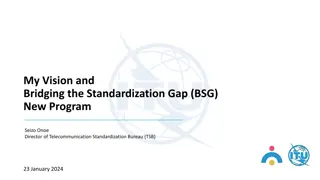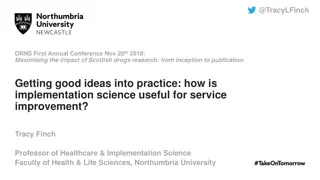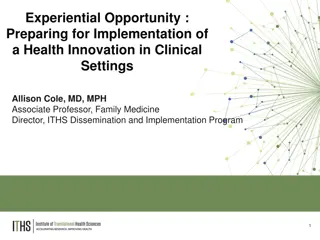Understanding Implementation Science: Bridging Research and Practice
This content delves into the principles of implementation science, discussing its significance, outcomes in research, and strategies to enhance the adoption of evidence-based practices. It defines key terms like dissemination and implementation, emphasizing the active approach to behavior change. Simplifying the distinction, it highlights the focus of implementation research on facilitating the execution of interventions rather than testing their effectiveness.
Download Presentation

Please find below an Image/Link to download the presentation.
The content on the website is provided AS IS for your information and personal use only. It may not be sold, licensed, or shared on other websites without obtaining consent from the author. Download presentation by click this link. If you encounter any issues during the download, it is possible that the publisher has removed the file from their server.
E N D
Presentation Transcript
Introduction to Implementation Science Geoffrey M. Curran, PhD Director, Center for Implementation Research Professor, Departments of Pharmacy Practice and Psychiatry University of Arkansas for Medical Sciences Research Health Scientist, Central Arkansas Veterans Healthcare System
HPV vaccine: 99+ % effective Healthy 2020 Goal = 80% adolescents 15 and under US recent: 42/29% AR recent: 34/16%
Naloxone Naloxone hydrochloride (naloxone) is an opioid antagonist that reverses the potentially fatal respiratory depression caused by opioids Stops overdose 2016: CDC recommendations 2017: Pharmacist standing orders 2018: 1 in 70 high dose prescriptions accompanied by naloxone dispensing
Goals for today Discuss principles of implementation science What is it? Why do we need it? When do we do it? Discuss outcomes in implementation research Adoption/uptake, fidelity to the intervention/practice Summarize different strategies to promote better implementation of evidence-based practices/interventions The interventions in this kind of work/research E.g., education, training, prompting, incentives, mandates
Some definitions Dissemination: targeted spread of information (from the NIH program announcement for Dissemination & Implementation research) Passive approach, focusing on knowledge transfer Implementation: An effort specifically designed to get best practice findings into routine and sustained use via appropriate uptake interventions. (Curran et al., 2012) Active approach, focusing on stimulating behavior change Implementation SCIENCE: The scientific study of methods to promote the systematic uptake of research findings and other evidence-based practices into routine practice, and, hence, to improve the quality and effectiveness of health services and care. (Eccles and Mittman, Implementation Science, 2006) Science of how BEST to implement, create generalizable knowledge QI = more local solutions
OK, so, some real scientific terms now When I teach about implementation research I often use this very simple language: The intervention/practice/innovation is THE THING In clinical effectiveness research, we are looking at whether THE THING works Patients get better because of the THE THING In implementation research, we are trying to figure out how best to help people/places DO THE THING Implementation strategies are the stuff we do to help people/places DO THE THING Main implementation outcomes are how much and how well the people/places DO THE THING Curran, Implementation Science Communications, 2020
So, why do we need implementation research? Only ~50% of patients in the US receive recommended/EB care Wide variability across conditions and treatment: 79% of patients receive recommended care for an age-related cataract 11% of patients receive recommended care for alcohol use disorder 20 25% patients get care that is not needed or potentially harmful So, we also need to DE-implement 1.3 million people are injured annually by medication errors Most chronic conditions have solid, evidence-based guidelines for treatment, management, and prevention, but rates of conditions such diabetes continue to rise
More why we need this 17 years on average from we know this works to routine delivery of it We have been citing this same figure for years Dissemination ONLY of research results, clinical practice guidelines (usually driven by research findings), etc., don t seem to do much on their own to improve practice delivery Except in some simpler cases Implementation of research findings/EBPs is a fundamental challenge for healthcare systems to optimize care, outcomes and costs
So, when do we do Implementation Research? (Research Pipeline ) Effectiveness Research Implementation Research Efficacy Research Improved processes, outcomes Preclinical Research NOT REALLY this linear
What are the outcomes we care about then? We are trying to measure changes in the delivery of care Did the place/people implement the intervention? Did they get started? Did they start and stop? Did everyone get it who should have gotten it? Was the intervention/practice delivered as much as it should have been? Were all indicated patients approached? Given intervention/practice? Did they do it right when the were delivering the intervention? Did they deliver the intervention as intended with fidelity ? How close did they get? Do we also look at the effectiveness of the intervention? Among those who got it, did they get better? Symptoms, functioning If the field does not have enough evidence on THE THING, then yes
Common Measures in Impl Research Adoption Counts and amounts Raw count of delivery Rates of delivery Fidelity How well performed LOTS of different ways to measure this Checklist; Expert rating Sustainability Stick with it or dropped it? Adoption and Fidelity measures over time If we are doing pilot/early work, then also look at
Implementation Strategies Depending on the characteristics of the practice, context, and people uptake interventions of some kind are usually necessary to support adoption we call those implementation strategies There are numerous types of implementation strategies available, many with research evidence supporting their use across contexts We will now discuss a taxonomy presented by Powell et al., and Waltz et al., 2015, Implementation Science They cover 73 strategies We ll hit some highlights (only about 26!)
Waltz et al Taxonomy of Impl Strats Train and educate stakeholders Develop educational materials Conduct educational meetings Conduct educational outreach visits (academic detailing) Personalized 1 on 1 sessions on intervention; Provide ongoing consultation In person, telephone, televideo ; usually about implementation progress Use train-the-trainer strategies More for widespread roll-outs ; Train local trainers/mentors Create a learning collaborative Groupings of learners/practitioners supported by trainers/experts Over time, experienced users teach new users (self-sustaining)
Waltz et al Taxonomy of Impl Strats Provide interactive assistance Provide clinical supervision Expert supervision focused on the intervention/practice being adopted Provide local technical assistance Needed usually for medical record, dispensing software tools Provide facilitation Interactive problem-solving; recommend and supply additional strategies Support clinicians Remind clinicians Electronic reminders in EMR or dispensing software; or manual This patient due for screening Revise professional roles E.g., expand role of pharmacists Create new clinical teams
Waltz et al Taxonomy of Impl Strats Change infrastructure Change physical structure and equipment Need new tech? Record system? Adequate space to provide interventions to patients?? Mandate change Create policies supportive of adoption of intervention/practice; Make people ? Change credentialing/licensing standards Make way for changing scope of practice, e.g., prescribing privileges to PharmDs Utilize financial strategies Place intervention on formulary/ covered list Alter incentive/allowance structure E.g., pay for performance of practice Penalize for not doing the intervention/practice Make billing easier
Waltz et al Taxonomy of Impl Strats Engage consumers Prepare patients/consumers to be participants Educate and prompt them to act; ask your pharmacist about Intervene with patients/consumers to enhance uptake/adherence Proactively approach patients; Let s talk about your adherence to this medication Use mass media Spread the word TV, posters, etc. Develop stakeholder relationships Identify and prepare champions Champion = local an enthusiastic supporter of intervention; driver of change Inform and use local opinion leaders Recruit influential practitioners to support the implementation Recruit, designate, and train for leadership Build a coalition Make a team that works together on the implementation
Waltz et al Taxonomy of Impl Strats Adapt and tailor to context Promote adaptability of the intervention Adapt intervention to match local needs, but don t sway from evidence-based-ness Tailor implementation strategies Tailor implementation strategies for local needs too Use evaluative and iterative strategies Audit and feedback Measure and feedback performance of practitioners/sites Conduct local needs assessment Before you start; identify barriers/facilitators to change and target strategies Conduct small cyclical tests of change Iterate your change process based on data (Plan/Do/Study/Act anyone?)
Strategies: What do we know? Disseminating and Training not so great on their own Many work OK (5-10% change in adoption) Reminders, Audit & Feedback, Academic detailing, Facilitation No combo offers a guarantee of success Many studies support the use of multi-component strats But some do not! Most multifaceted strategies involve 2 or more of these: education/training, prompts of some kind, audit and feedback Highly regarded, only somewhat supported, is the idea that strategies work better when matched to barriers/needs identified through diagnostic analysis
So many questions to answer Why don t the strategies we have now work better? Which strategies work best under what conditions/contexts? Which strategies are cost-effective (in which context )? How do we get EBPs to low resource counties and countries? Rural US? How best to feasibly measure fidelity? How much does fidelity matter to effectiveness outcomes? De-adoption strategies? Sustainability? These are just a few
Models, Theories, Frameworks Yeah, I know
Determinant Frameworks understand or explain influences on implementation. Consolidated Framework for Implementation Research (CFIR) Characteristics of the intervention Complexity, cost, relative advantage Outer setting External policies, guidelines, incentives... Inner Setting Organizational culture and climate, readiness for implementation, infrastructure Characteristics of Individuals Knowledge, beliefs, self-efficacy Process Planning, executing, reflecting Used a lot to study barriers/facilitators to uptake Used a lot to help select strategies to test
OK, few more frameworks, thats it Process models EPIS: Exploration, Preparation, Implementation, Sustainment Why important: Helps think about what kinds of strategies you ll need for each step Evaluation frameworks RE-AIM: Reach, Effectiveness, Adoption, Implementation, Maintenance Proctor framework: See above slides Why important: Helps answer the question, How do I show this strategy worked or didn t?
Selected IS Resources on Campus HMPT 6319: Implementing Change in Clinical Practice Settings HMPT 9329: Advanced Topics in Implementation Science IS Scholars Program 2 year program for clinician scientists Monthly group consultations Center for Implementation Research 4th Wednesday at 1pm
Some common designs in implementation research Remember, these designs are assuming the traditional pipeline and that it has produced suitable EBPs in need of implementation support This is not always true, but we re leave that alone today In this summary, I will focus on places doing the adopting Easier to talk about places, but many studies focus on providers I won t provide a detailed overview of the designs, but discuss some common ones within these categories: Within-site designs Between-site designs
Within-Site Designs We use these when we want or need to expose all places to the same thing/strategy No comparison places; common in QI type scenarios or pilot tests of strategies in development (research scenarios) VERY COMMON in Community Pharmacy Practice Research Causal inference difficult, but many real-world uses for these data Post-only design Simplest Can be used when we know baseline use of EBP is zippo Pre-Post design Often used when some adoption has been attempted, but it has not achieved the desired level
Between-Site Designs We use these when we want to expose places to different things/strategies Causal inference improved when places are randomized to different exposures (not always possible tho; when not, try to balance places on important measures) New Strategy vs. implementation as usual Key is to choose useful implementation as usual Common in healthcare settings = disseminate, plus training, plus a little technical support New Strategy 1 vs. New Strategy 2 Comparative effectiveness trial of 2 different strategies (or packages of them) Different doses of same type of strategy (lo/hi intensity)? Different types? SMART designs: start all with low intensity, then randomized non-responders to higher intensity strategy























